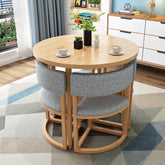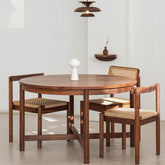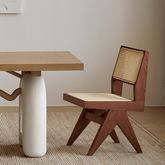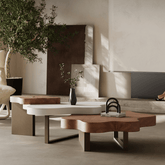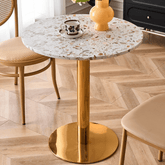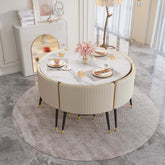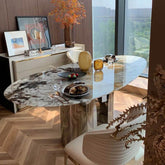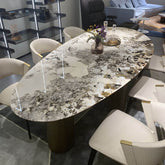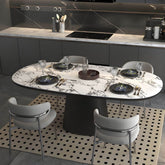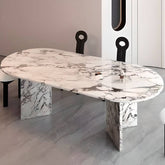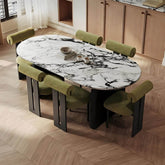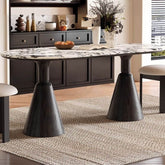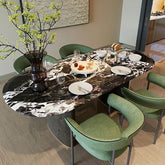Can Marble Tables Be Used Outdoors? Everything You Need to Know
Introduction: The Allure of Marble and the Question of Outdoor Use
Marble, with its timeless elegance and luxurious appeal, has long been a favored material for interior design. From grand foyers to sophisticated kitchen countertops, its unique veining and smooth finish add an undeniable touch of class. As our living spaces increasingly extend outdoors, the desire to incorporate such refined elements into patios, gardens, and balconies has grown. This naturally leads to a crucial question: Can marble tables truly withstand the rigors of the outdoor environment? While the idea of a stunning marble table gracing your al fresco dining area is certainly appealing, there are common misconceptions about its durability and suitability for outdoor use that need to be addressed.

Characteristics of Marble: Why It's Both Suitable and Unsuitable for Outdoor Use
Marble is a metamorphic rock, primarily composed of recrystallized carbonate minerals, most commonly calcite or dolomite. Its formation under intense heat and pressure gives it distinct characteristics that contribute to both its beauty and its vulnerabilities when exposed to the elements.
Pros:
- Durability and Longevity (with proper care): Marble is inherently a strong and dense material. When properly cared for and maintained, a marble table can last for many decades, even centuries, as evidenced by ancient marble structures that still stand today. Its robustness makes it resistant to physical wear and tear under normal conditions.
- Heat Resistance: Marble possesses excellent heat resistance, making it a comfortable surface for outdoor use, especially in warmer climates. Unlike some synthetic materials that can become unpleasantly hot in direct sunlight, marble tends to remain relatively cool to the touch, providing a pleasant dining or lounging experience.
- Aesthetic Appeal and Natural Beauty: The primary draw of marble is its unparalleled aesthetic. Each slab is unique, featuring intricate patterns and a lustrous finish that adds a sophisticated and high-end look to any setting. Outdoors, it can create a striking focal point, elevating the overall design of your patio or garden.
Cons:
Despite its many advantages, marble also has significant drawbacks that make its outdoor use challenging:
- Porous Nature and Susceptibility to Staining (Etching from Acids): Marble is a porous stone, meaning it has tiny capillaries that can absorb liquids. This makes it highly susceptible to staining from spills like wine, oil, or even water if left to sit. More critically, marble is primarily composed of calcium carbonate, which reacts with acids. Rainwater, which is often slightly acidic, as well as acidic foods and drinks (e.g., lemon juice, vinegar, soda), can cause etching – a dulling or roughening of the surface where the acid has dissolved the stone. This damage is permanent and can significantly detract from the marble's appearance.
 * Vulnerability to Scratching and Chipping: While durable, marble is a relatively soft stone compared to granite or quartzite. This softness makes it more prone to scratching from abrasive materials or chipping if heavy objects are dropped on its surface. Outdoor environments, with their increased exposure to debris and potential impacts, can exacerbate this vulnerability.
* Vulnerability to Scratching and Chipping: While durable, marble is a relatively soft stone compared to granite or quartzite. This softness makes it more prone to scratching from abrasive materials or chipping if heavy objects are dropped on its surface. Outdoor environments, with their increased exposure to debris and potential impacts, can exacerbate this vulnerability.
- Weight and Difficulty in Moving: Marble is an incredibly heavy material. A marble table, especially a large one, can be extremely difficult to move. This poses a challenge if you need to reposition it frequently, bring it indoors for winter storage, or protect it during severe weather events.
- Sensitivity to Extreme Temperature Fluctuations (Cracking): While heat resistant, rapid and extreme temperature changes can be detrimental to marble. In regions with harsh winters, the freeze-thaw cycle can cause water absorbed into the pores to expand when frozen, leading to cracks or spalling (flaking of the surface). This is a significant concern for outdoor marble in climates with wide temperature swings.
- Polished Marble Dulls Over Time Outdoors: Polished marble achieves its high shine through a mechanical process that smooths the surface. When exposed to outdoor elements like UV radiation, rain, and airborne particles, this polished finish can dull and lose its luster over time, requiring professional re-polishing to restore its original appearance.
Types of Marble and Their Outdoor Suitability
Not all marble is created equal, and the specific type can significantly influence its performance outdoors. Understanding the differences can help you make a more informed decision.
Best Choices:
- Honed or Unpolished Marble: For outdoor applications, a honed or unpolished finish is generally preferred over polished marble. This matte finish is less prone to showing etching and scratches, as it doesn't rely on a highly reflective surface. It also offers better grip, which can be a safety advantage in wet conditions.
- Denser, Less Porous Marble Varieties: Some marble varieties are naturally denser and less porous than others, making them more resistant to moisture absorption and staining. While true marble will always be somewhat porous, opting for a denser type can offer a slight advantage. It's also worth noting that some materials often mistaken for marble, such as certain granites or quartzites, are far more suitable for outdoor use due to their superior hardness and non-porous nature. If you're set on a 'marble look' for outdoors, exploring these alternatives might be a more practical solution. Specific marble types like Verde Alpi are sometimes cited as being more resistant to atmospheric conditions, but even these require diligent care.
Avoid:
- Polished Marble: As mentioned, polished marble is highly susceptible to dulling, etching, and scratching when exposed to outdoor elements. Its pristine, reflective surface is easily compromised by rain, UV rays, and acidic substances, making it a poor choice for uncovered outdoor areas.
- Highly Porous or Soft Marble Varieties: Lighter-colored marbles, particularly those with significant veining, tend to be more porous and softer. These varieties will absorb liquids more readily and are more susceptible to damage from freeze-thaw cycles and acidic exposure. If you're considering marble for outdoors, avoid these softer types.
Practical Considerations for Outdoor Marble Tables
If you decide to use a marble table outdoors, careful planning and ongoing maintenance are crucial to preserve its beauty and longevity. Ignoring these considerations can lead to rapid deterioration and disappointment.
Location:
- Covered Patios or Sheltered Areas are Ideal: The best way to protect an outdoor marble table is to place it in a location that offers significant shelter from the elements. A covered patio, a gazebo, or an area under a large awning will shield the table from direct rain, harsh sunlight, and falling debris. This significantly reduces the risk of staining, etching, and temperature-related damage.

- Avoid Direct Exposure to Sun, Rain, Snow, and Extreme Temperatures: Direct sunlight can cause polished marble to dull and fade over time, while rain and snow introduce moisture that can lead to etching and freeze-thaw damage. Extreme temperature fluctuations, both hot and cold, can stress the stone and increase the likelihood of cracking. If a covered area isn't available, consider a location that receives partial shade throughout the day or is less exposed to prevailing winds and precipitation.
Maintenance:
Regular and diligent maintenance is non-negotiable for outdoor marble tables.
- Regular Cleaning with Mild Soap and Water: Dust, pollen, and general outdoor grime can accumulate on the table's surface. Clean the table regularly with a soft cloth or sponge and a pH-neutral, mild soap (like dish soap) mixed with warm water. Avoid abrasive cleaners, acidic solutions, or harsh chemicals, as these can damage the marble's surface and sealant.
- Frequent Sealing (Every 6-12 Months) to Prevent Staining and Etching: Sealing is perhaps the most critical maintenance step for outdoor marble. A good quality impregnating sealer penetrates the stone, creating a barrier that repels liquids and helps prevent staining and etching. For outdoor tables, sealing should be done more frequently than for indoor marble, typically every 6 to 12 months, depending on exposure and usage. Always follow the sealer manufacturer"s instructions carefully.
 * Immediate Cleanup of Spills: Due to marble's porous nature, any spills, especially those involving acidic liquids (wine, fruit juice, soda) or oils, should be wiped up immediately. The longer a spill sits, the higher the chance of it penetrating the stone and causing a permanent stain or etch mark.
* Immediate Cleanup of Spills: Due to marble's porous nature, any spills, especially those involving acidic liquids (wine, fruit juice, soda) or oils, should be wiped up immediately. The longer a spill sits, the higher the chance of it penetrating the stone and causing a permanent stain or etch mark.
- Using Coasters and Placemats: Even with sealing, it's wise to use coasters under drinks and placemats under plates to provide an extra layer of protection against spills and scratches.
Protection:
Beyond regular maintenance, proactive protection measures are essential.
- Using Outdoor Furniture Covers During Harsh Weather or Off-Season: Invest in a high-quality, waterproof outdoor furniture cover that fits your marble table snugly. Use this cover during periods of heavy rain, snow, strong winds, or when the table is not in use for extended periods (e.g., during the off-season). This provides a physical barrier against the elements.

- Bringing Indoors During Winter or Extreme Conditions: In climates with freezing temperatures and significant snowfall, the safest option for a marble table is to bring it indoors for the winter months. This completely eliminates the risk of freeze-thaw damage and prolonged exposure to harsh winter conditions. If bringing it indoors is not feasible, ensure it is thoroughly cleaned, sealed, and covered with a robust, breathable cover.
FAQs: Your Top Questions Answered
Here are some frequently asked questions about using marble tables outdoors, providing quick answers to common concerns.
-
Is marble waterproof? No, marble is not waterproof. It is a porous material, meaning it has tiny pores that can absorb liquids. While sealants can help repel water and prevent staining, they do not make the marble entirely waterproof. Prolonged exposure to moisture can still lead to issues like etching, staining, and in freezing conditions, cracking.
-
How often should I seal my outdoor marble table? For outdoor marble tables, it is generally recommended to seal them every 6 to 12 months. However, the frequency can vary depending on your climate, the amount of exposure to elements, and the type of sealant used. In areas with heavy rain, extreme temperatures, or frequent use, you might need to seal it more often. A simple water test can help determine if resealing is needed: if water no longer beads on the surface but soaks in, it's time to reseal.
-
What kind of cleaner should I use for outdoor marble? Always use a pH-neutral cleaner specifically designed for natural stone, or a mild dish soap mixed with warm water. Avoid acidic cleaners (like vinegar or lemon-based products), abrasive cleaners, or harsh chemicals, as these can etch or damage the marble surface and strip away the sealant. Always test any new cleaner on an inconspicuous area first.
-
Can extreme cold damage marble? Yes, extreme cold, especially coupled with moisture, can damage marble. The freeze-thaw cycle is particularly harmful. If water is absorbed into the marble's pores and then freezes, it expands, creating pressure that can lead to cracks, spalling, or delamination of the stone. This is why bringing outdoor marble tables indoors or covering them thoroughly in winter is highly recommended in cold climates.
-
What are the best alternatives to marble for outdoor tables? If the maintenance and vulnerability of marble are concerns for outdoor use, several excellent alternatives offer similar aesthetic appeal with greater durability:
- Granite: A very hard, dense, and less porous natural stone that is highly resistant to scratches, heat, and etching. It's an excellent choice for outdoor countertops and tables.
- Quartzite: Another natural stone, harder than marble and less porous, offering a marble-like appearance with superior outdoor performance.
- Porcelain: Highly durable, non-porous, and resistant to stains, scratches, heat, and UV fading. Porcelain slabs can mimic the look of marble very convincingly.
- Concrete: Can be molded into various shapes and finishes, offering a modern, industrial look. It's durable but can be heavy and may require sealing.
- Teak Wood: A naturally weather-resistant hardwood that develops a beautiful patina over time. It's durable and requires minimal maintenance.
- High-Pressure Laminate (HPL): Modern HPL can be designed to look like marble and is highly resistant to weather, scratches, and fading, making it a practical and cost-effective outdoor option.
Conclusion: Making an Informed Decision
So, can marble tables be used outdoors? The answer is a nuanced yes, but with significant caveats. While marble offers undeniable beauty and heat resistance, its porous nature, susceptibility to etching and staining, vulnerability to scratching, and sensitivity to freeze-thaw cycles in harsh climates make it a high-maintenance choice for outdoor environments. It is not a material you can simply place outside and forget about.
To ensure the longevity and aesthetic appeal of an outdoor marble table, you must be prepared for diligent care. This includes strategic placement in covered areas, frequent sealing, immediate cleanup of spills, and protective measures like covers or even bringing the table indoors during extreme weather. For those seeking a truly low-maintenance outdoor solution, alternatives like granite, quartzite, or porcelain might be more suitable.
Ultimately, the decision rests on your willingness to commit to the necessary maintenance and protection. Assess your local climate, your lifestyle, and your dedication to care before investing in an outdoor marble table. With the right approach, a marble table can indeed be a stunning addition to your outdoor living space, but without it, you risk disappointment and damage.
References
- Karen Pearse Home: Everything You Need To Know About Using Marble Outdoors: Provides insights into using marble outdoors and types of marble suitable for outdoor use.
- Omni Surfaces: Can Marble be used Outdoors? A Bold Move or a Risky Venture?: Discusses considerations and maintenance for outdoor marble.
- Oixdesign: Can You Use Marble Tables Outside?: Offers pros and cons and practical advice for outdoor marble tables.
- Marmol Export-Usa: Choosing and Maintaining Outdoor Marble: Provides guidance on selecting and caring for outdoor marble.
- Academy Marble: Tips for Caring for Outdoor Natural Stone: General tips for natural stone care, including marble, in outdoor settings.
